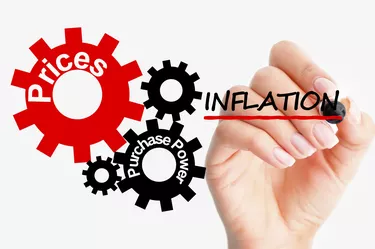
The often overlooked effect of inflation is critical to financial planning, because it not only affects the future prices of goods but also the relative value of your money over time. As an example, if you never received a raise, your salary would effectively degrade over time, because its buying power would decrease. To ensure your economic growth, it is vital to learn how to factor in inflation when planning for your future, especially when it comes to retirement.
Finding Inflation Data
Video of the Day
According to the Bureau of Labor Statistics, the U.S. government calculates inflation using the change of prices for a wide range of products and services and bases this calculation on numerous indexes. The Federal Reserve favors the Department of Commerce's personal consumption expenditure, or PCE, index due to its wide range of weighted expenditures, but the Fed and other departments also use the Bureau of Labor Statistics' consumer price index . The Fed targets a 2 percent rate of inflation, based on the PCE, because higher rates impede long-term predictions and lower rates increase the risk of deflation in a weakened economy.
Video of the Day
Consider Also: Inflation Rate vs. Growth Rate
Inflation's Effect on Prices
Investopedia reports that inflation is calculated by the actual change in prices of consumer goods, but you can use historical inflation data to estimate future prices, which can help you ensure that your financial planning is as accurate as possible. Calculate this figure by adding 1 to the rate of inflation, raising the result to the number of years and multiplying the result by the current price.
As an example, if the current rate of inflation is 2 percent and you wanted to estimate the cost of a $200 item 10 years from now, raise 1.02 to the power of 10 and multiply by 200 to get the future value of $243.
Inflation's Effect on Buying Power
Because on average prices tend to increase over time, the same amount of money today is more valuable than in the future. The calculation of the future value of money works exactly as it does for prices, except the rate of inflation is subtracted due to its degrading effect on existing money.
As an example, using the same 2 percent inflation rate and 10-year prediction, you can calculate the future value of $200 cash by subtracting 0.02 from 1, raising the resulting 0.98 to the power of 10 and multiplying the result by $200 to get a future value of $163.41. If you would rather not do the math yourself, you can use a future inflation calculator online to arrive at the same numbers.
Consider also: How to Calculate Inflation Rate From CPI
Inflation's Effect on Investment Returns
Although it's tempting to simply subtract the inflation rate from the anticipated rate of return on investments to factor in inflation, doing so only offers a rough estimate. A better alternative is to add 1 to both rates, divide the nominal result by the inflation result and subtract 1.
As an example, if the rate of return is 5 percent and the inflation rate is 2 percent, divide 1.05 by 1.02 and subtract 1 to get a real rate of return of 0.029, or 2.9 percent. You can then use this figure in a standard compound interest formula, similar to the inflation-adjusted price calculation.